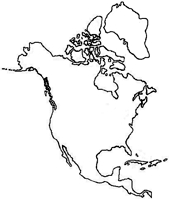
|
The Society of Folk Dance Historians (SFDH) North America
Home |
About |
Encyclopedia | CLICK IMAGE TO ENLARGE |

|
BACKGROUND
Information: A continent (and islands such as Greenland).
North America was reached by its first human populations during the last glacial period, via crossing the Bering land bridge approximately 40,000 to 17,000 years ago. The so-called Paleo-Indian period is taken to have lasted until about 10,000 years ago.
Geologically, Canada is one of the oldest regions in the world, with more than half of the region consisting of precambrian rocks that have been above sea level since the beginning of the Palaeozoic era. The lower forty-eight United States can be divided into roughly five physiographic provinces: the American cordillera, the Canadian Shield (Northern portion of the upper midwestern United States), the stable platform, the coastal plain, and the Appalachian orogenic belt. The geology of Alaska is typical of that of the cordillera, while the major islands of Hawai'i consist of Neogene volcanics erupted over a hot spot.
European influences are strongest in the northern parts of the continent while indigenous and African influences are relatively stronger in the south. Because of the history of colonialism, most North Americans speak English, Spanish, or French and societies and states commonly reflect Western traditions.
Languages: Predominantly English, Spanish, and French.
Religion: Predominantly Christian.
COUNTRIES AND REGIONS
- Appalachia – an ethnic region.
- Canada – a country.
- Caribbean – a region.
- Central America – a region.
- Greenland – a country (belonging to Denmark).
- Mexico – a country.
- United States – a country.
REFERENCE
- Engineering in Ancient America, by Robert E. Fix, 1965.
DOCUMENTS
- Contra, a dance family.
- Folk Dance in North America, an article.
- Folk Dance Research, an article.
- Mary Shafter, an article.
- Native American, a list.
- Square Dance, a dance family.
- Old Square Dances of America, a book.
This page © 2018 by Ron Houston.
Please do not copy any part of this page without including this copyright notice.
Please do not copy small portions out of context.
Please do not copy large portions without permission from Ron Houston.